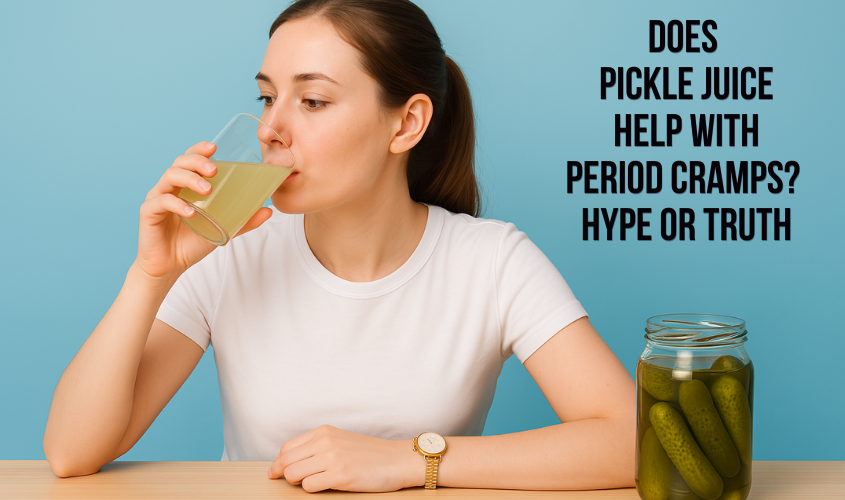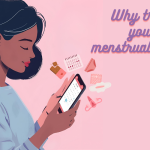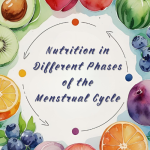
- 26.03.2025
- Menstrual Health Blog
Imagine it’s the first day of your period, and your body feels like it’s been thrown into a wrestling match it didn’t sign up for. The pain twists and pulls, your uterus staging its monthly rebellion with all the drama of a soap opera villain. Menstrual cramps are a universal struggle, hitting nearly everyone who deals with a cycle like clockwork. Some of us hug heating pads until they’re practically family, others brew herbal tea in a desperate ritual, or pop painkillers just to make it through the day. Anything that promises a sliver of relief feels like a gift when you’re curled up, clutching your stomach. Recently, though, an oddball contender has elbowed its way into the conversation—pickle juice. That salty, slightly murky stuff left in a jar of pickled cucumbers is suddenly everywhere, with folks claiming it banishes cramps faster than you can say “dill.” TikTok’s drowning in videos of girls hyping it up like it’s the cure of the century. So, does pickle juice help with period cramps? Is this a real shot at easing the misery, or just another trendy myth that’ll fade into the ether? Let’s break it down, piece by piece, and figure out if it’s worth keeping a jar on standby.
How Does Pickle Juice Help with Period Cramps as a Remedy?
Pickle juice didn’t waltz onto the stage as a menstrual pain superstar—it’s been earning its stripes elsewhere for a while. Long before it became the latest buzzword in period relief circles, athletes were already singing its praises. Think of runners slogging through a marathon, legs seizing up, or football players mid-game, hobbling with cramps. They’d grab a cup of pickle juice on the sidelines, chug it like it’s some kind of sports drink, and bam—no more limp. I once saw a teammate do it during a track meet; she swore it was like flipping a switch. That’s how it carved out its niche as a muscle cramp fixer. But its story didn’t end on the field—it spilled over into everyday life, and the internet lit the fuse.
Social media took this humble jar juice and launched it into orbit. Flip through TikTok, and you’ll catch a girl sipping it straight from the source, captioning it, “Cramps gone in 10 minutes, y’all—game over!” These clips pull in millions of views, with comments like, “No way, trying this tomorrow!” or “This is my new religion.” Over on X, it’s just as wild—one user posted, “Pickle juice saved my period week, I’m never going back to the old ways,” and the replies were a chorus of “same!” Friends are in on it too; I got a text from a pal last month: “Dude, you’ve got to try this, it actually works—I’m stunned.” Even celebrities are fanning the flames—an actress dropped it as her “weird wellness hack” on a podcast I was half-listening to, and next thing you know, it’s trending. What started as a forgotten leftover in a pickle jar has ballooned into a cultural moment. But here’s the rub: just because it’s loud doesn’t mean it’s legit. Is it really a fix, or are we all just swept up in the hype? Time to get serious.
Does Pickle Juice Help with Period Cramps? The Science Says
Okay, what’s in this so-called “miracle drink” that’s got everyone losing their minds? It’s pretty basic: water, vinegar, a truckload of salt, and sometimes a dash of potassium or magnesium if the pickles were fancy. It’s not exactly a potion you’d whip up in a lab—it’s more like something you’d splash on a sandwich. But could this simple mix actually take down cramps? Let’s poke around the science and see what’s what.
The research we’ve got is a breadcrumb trail, mostly about muscle cramps rather than the menstrual kind. A 2010 study in a sports journal caught my eye—it showed pickle juice beating out plain water, stopping cramps in under two minutes flat. The eggheads behind it figured the vinegar might ping the nervous system, like a little “calm down” signal to muscles freaking out. I’ve seen it work firsthand; my cousin downed some during a soccer game and was back sprinting like nothing happened. Menstrual cramps, though? They’re a whole different monster. The uterus clenches to shed its lining, egged on by prostaglandins—those pesky chemicals that turn the dial to “ouch.” Could the salt keep your hydration on lock, easing some of that tension? Might the vinegar hush those wild contractions? It’s not a stretch, but there’s no smoking gun yet.
Here’s the kicker: no one’s run a proper experiment on pickle juice and menstrual cramps specifically. It’s all a big “what if”—if it works for a runner’s calf, maybe it could help a uterus too? I’d love more meaty data—something like this guide on painful periods digs into what makes cramps tick and why they hurt so bad. Hydration’s a big deal for pain, and pickle juice’s electrolytes—sodium, maybe some potassium—could play that card. Magnesium’s a muscle relaxer too; I’ve heard folks say it helps their cramps when they pop supplements. But without a study staring us down, it’s a theory dangling on hope, not a fact set in stone. It’s intriguing, sure, but it’s not ready to wear the crown.
What Do Experts Say?
Let’s cut the guesswork and lean on the pros. Dr. Jane Minkin, a Yale gynecologist with serious cred, told a magazine that salt and vinegar might mess with muscle tension or hydration in a helpful way. “The idea isn’t nonsense,” she said, “but don’t toss out the ibuprofen just yet.” I like that—it’s not a hard no, but she’s keeping it real; the old reliables still rule.
Dr. Sarah Thompson, a women’s health expert, is more on the fence: “It’s not clear-cut.” She brings up the placebo effect—believe in a fix, and your brain might convince you the pain’s lighter. “Some patients swear by pickle juice,” she adds, “but a heating pad or pills have far more evidence stacked up.” That hits home; I’ve had days where just thinking tea would help made it feel like it did. There’s solid gold out there—like this breakdown of cramp relief strategies—built on years of real data and hands-on experience.
Dietitians toss in their two cents: hydration can dial down cramps, and pickle juice’s electrolyte haul could step up if you’re dried out. I’ve noticed myself—when I’m chugging water, the pain’s less of a beast. Experts seem to agree it’s not a total dud, but it’s no silver bullet either. It’s cool to try, but don’t ditch the doctor or your trusty standbys—they’ve got deeper roots.
Risks to Consider of This Method
Before you start guzzling pickle juice like it’s the fountain of youth, let’s talk downsides. It’s salty—around 800 mg of sodium per cup, which is a hefty punch. Periods already make me feel like a bloated marshmallow half the time, and extra salt could turn that up to eleven. Plus, too much sodium can nudge blood pressure, a legit worry if your ticker or veins are sensitive—I’ve got a friend who watches that like a hawk.
Vinegar’s another wild card. It’s the zing in pickle juice, but for a touchy stomach—like mine after too much coffee—it might kick off heartburn, burps, or that “uh-oh” feeling that lingers. If your kidneys are glitchy or you’re pregnant, steer clear; docs say water’s your best buddy then. Start small—a 2-3 ounce shot, about a shot glass—to test the waters. I tried that once with a weird tea blend; sipping saved me from a regretful chug. Downing a whole jar? You’re asking for bloating or nausea, which is the last thing you need.
Curious about testing quirky fixes safely? The Selin App User Manual has some smart pointers. Point is: pickle juice has perks, but it’s got baggage. Experiment if you’re up for it—just don’t dive in blind.
Does Pickle Juice Help with Period Cramps: Is It Worth a Shot?
So, does pickle juice help with period cramps? We’re landing at “maybe, but no guarantees.” It’s got a rap sheet with muscle cramps—athletes back it hard—and some period-havers call it a lifeline. A buddy of mine said, “Took a sip, and I felt human again—crazy!” The placebo effect could be in the mix too; if you’re sold on it, your brain might ease up on the pain signals.
But here’s the deal: no research has nailed it for menstrual cramps. No scientist’s stamped it “certified,” and risks like bloating or stomach grumbles are real—I’ve felt that puffiness myself. Heating pads, hot tea, or ibuprofen? They’re the MVPs, backed by time and tons of use. If cramps get savage, a jar’s not your hero—call a doc. Oh, and the Selin App period tracker is clutch for logging cycles and pinpointing what actually works.
Worth a shot? If a jar’s handy and you’re curious, a few sips when cramps hit won’t wreck you. But don’t bank on it solo—cramps are a personal beast; what’s gold for one might flop for another. If you’re game to ride this trend, go ahead, but keep your hopes mellow. It’s about knowing your body and surviving that monthly mess with as little chaos as possible.











